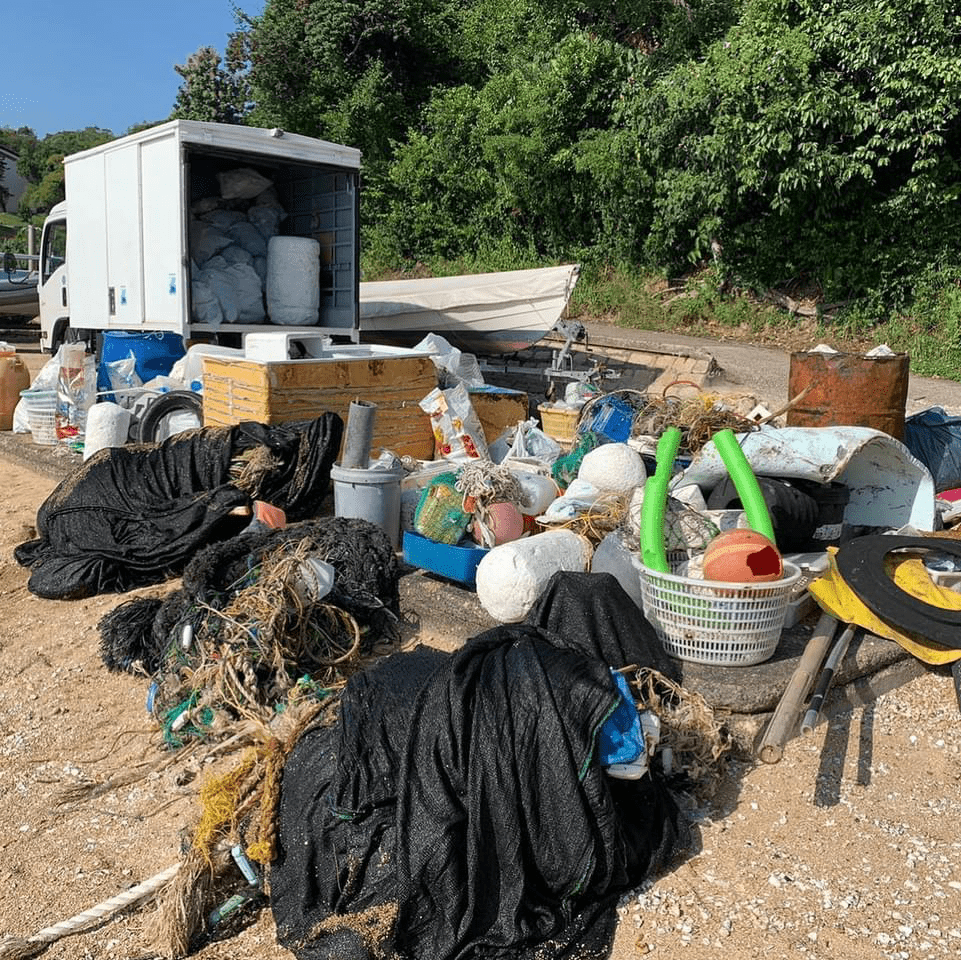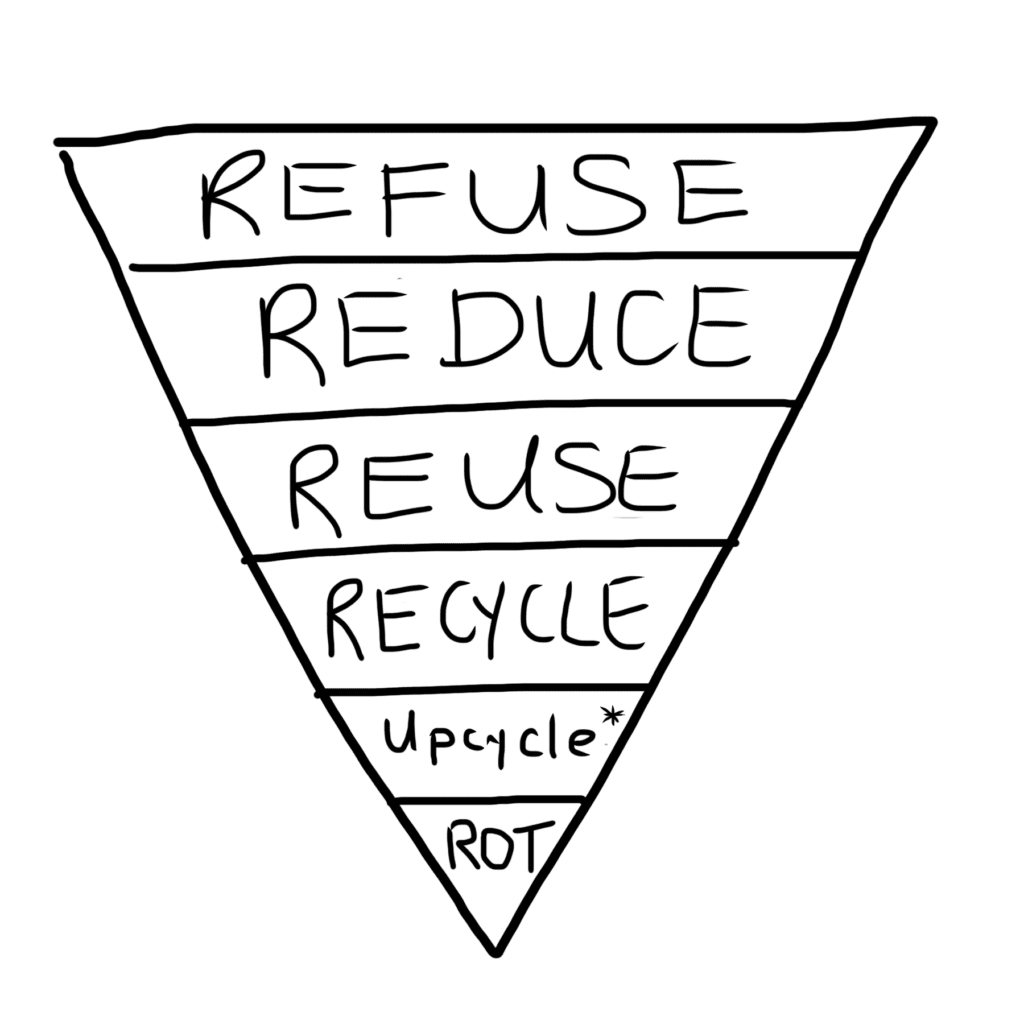
Recycling isn’t enough, we need to decrease our plastic use.
With the fast and cheap production of single-use plastic ‘disposables’, plastic pollution has been increasing exponentially in recent years. Since the 1950s, approximately 2.3 million tons of plastic has been produced. In 2015, we have seen an astonishing 448 million tons of plastic sold by manufacturers, and these numbers are expected to double by 2050. But at what cost, we ask? Every year, 8 million tons of plastic waste seeps into the ocean. It takes 400 years for these plastic wastes to break down – in some cases, much longer. The accumulation of these plastics will eventually have us all drowning in our own waste.
What is plastic? What’s the big deal about plastic waste now?
Plastic, by definition, is made from crude oil. Crude oil is centuries of compressed fossils (yes, the very same dinosaur and flora fossils that you see in natural history museums!). Crude oil is a limited resource on our planet, yet most modern lifestyles are truly dependent on it. From life-saving medical equipment and devices, to space travel, to manufacturing lighter cars for fuel reduction, to single-use disposables for convenience sake – it’s everywhere, no matter which way we turn.
But how did we get to the point that our plastic production is destroying the very planet we reside upon? After WWII the acceleration of plastic materials was seen as a modern revolution, where the thought of ‘throwing away for convenience’ was such an awe inspiring moment for the public. It was a revelation and modern change from the vintage reusables which our grandparents were used to. Flash forward to 2019, it became a pressing environmental issue on a global scale: the throwaway culture mindset took over nature and started harming marine wildlife, and, in turn, impacting our health. Single-use plastic disposables accounts for 40% of manufactured plastic, such as food packaging and plastic bags, which are used for mere seconds and thrown into landfills where they will persist for hundreds of years.

Image 1: Beach clean up from Adventure Clean Up Hong Kong with Outward Bound Hong Kong
Read more about how microplastics are affecting our global diets and oceans.
Although we have bioplastic (made from corn, straw, and wood) thanks to the use of aniline (a key chemical in plastic), we still live in a throwaway culture that is heavily marketed as ‘compulsory convenience’ through the sale of disposable plastic products. The most important change which needs to be implemented in our personal lives is to reduce our plastic waste, rather than completely avoid it as conscious consumers – which is just not 100% feasible for most local communities! After all, we live in a capitalist global economy where plastic is made cheaply for bigger profits. It’s such a huge environmental problem that the United Nations has prompted countries to sign a global treaty in reducing their plastic trash due to the Great Pacific Garbage Patch.
Fine, I get it. Plastic waste is a dramatic environmental issue. But, where do I start? How can I help with this?
Do a bin audit
Let’s ask ourselves, how much do we throw into our kitchen bins every week? Is it a trash bag everyday or every few days instead? Take a look in your bin and fish out the mess to count how many different types of waste that have been absentmindedly thrown in there: plastic, paper, metal, and unrecyclable mixed materials which are hard to differentiate for recyclers. A fair warning, it will be messy to do a bin audit, so we advise you to do so before you chuck out your recycling and (food) waste. Take a piece of scrap paper and stick it on your fridge, or even better, make a note on your phone about what trash material went into your kitchen bin. Take a step further and audit your bathroom bin too! You would be surprised what goes into your bathroom bin too!
Reduce your plastic and recycling waste
Now that you’ve done a bin audit, it’s time to analyse what is the most wasteful habit that you’ve thrown out mindlessly. You might have more plastic packaging. You might have more mixed material packaging that you didn’t know what to do with but bin. You might have more ‘wet waste’: food leftovers, expired forgotten food from the fridge, and stinky mouldy food that had been brewing at the back of your cupboards.
Sure, you can recycle most packaging (depending on what your local council and/or waste collection takes in) but we can all learn to reduce our waste intake. 91% of plastic isn’t actually recycled due to food contamination and lack of recycling resources (especially for hard to recycle plastic numbers and mixed material plastics). Only a small percentage of plastic are downcycled; they degrade each time they get ‘recycled’ to the point where they can’t be remade into new plastic materials, leaving it for the landfills. This is why it’s important to reduce your recycling, and rather reuse your recycling instead!

How do I reduce my recycling?
- Opt for the biggest packaging available for pantry staples and other produce. The bigger the packaging, the more chance it will be recycled off. Tiny bits of microplastic aren’t picked up by recycler’s sorting machinery and will end up in landfills or in the ocean. Cutting down on smaller individual packaging, whether be it plastic or not, also reduces the amount of packaging waste too. That’s what you should aim for!
- Avoid (or reduce) your black plastic packaging. More often than not, black plastic materials aren’t detected as easily by the recycler’s sorting machinery, and thus ends up in the landfill pile at the recycling plant. Please check with your waste collection / local council rules on plastic recycling – not everyone collects black plastic and certain plastic materials!
- Whenever possible, opt for more recyclable materials, such as paper, metal, and glass. Many of these materials can be infinitely recycled, and are often made from their old counterparts. Go a step further and check if they are sustainably certified, e.g FSC certified paper from managed forests, recycled (ocean) plastic packaging, and metal made from recycled metal parts. Our tip: of course, we acknowledge the fact that everyone has different accessibility and affordability – don’t fret if the packaging isn’t “certified” or “sustainably claimed”! You’re doing great if you’re trying to do better in any way!
- Reuse your recyclable plastic and glass containers. Just because they can be easily tossed into your recycling bins, doesn’t mean they can’t be used again for bulk food shopping and storing your pantry things. Our tip: tear off the labels to give your upcycled containers a fresh ‘clean’ look on your kitchen shelves. Feel free to paint and draw on them! Make sure to check the weight of your container before your shopping trip to avoid paying extra in shops, although some shops have scales for this too.
- Reuse metal tins for ‘bulk’ produce. If you’re a sweets lover, bring those upcycled tins to ‘a pick n mix’ sweets place just like how your grandparents did. Or if you’re a millennial coffee/tea addict, bring it round to a local coffee shop/roaster – feel free to ask them where their beans/leaves origins were from, and if they work directly with the farmers! Our tip: ask them on how to store coffee beans properly in your container – less food waste is important too.
- Use reusables (eg: tupperwares, metal or glass containers, and, yes, even your upcycled glass jars and plastic containers) when grocery shopping. This cuts down on excess packaging waste from local shops, wet markets, farmer’s markets and supermarket delis. Plus, it means less recycling to sort out at home in the end! Note: please ask the staff before handing your containers as they may have hygiene protocols to follow during Covid19. If you can’t use your own containers, ask for the least amount of wrapping if they could do so.
- Refuse single-use disposables. Take those kitchen drawer cutleries and roll them up in a hanky or tea towel for work takeaway lunches. Ask for ’no contact’ coffee in your tumbler (or reusable cup) while you hold onto your cup for them to pour your drink. Bring your own water bottle on walks, if you have clean water access, instead of buying plastic bottled water. And, even if you have to take in disposable cutleries, paper cups, and takeaway containers during Covid19 – reuse it before recycling or binning them. They can be used for upcycled crafts, growing seedlings, or organising your numerous cables and wires which came from the unknown ether.
- Embrace the ‘secondhand consumption’’ culture for a more frivolous circular economy. Give some love and a second chance to unwanted things which people have decluttered during their in-house quarantine. It’s one way to reduce waste and cut down on consuming things made from new resources by using others’ ‘trash’. Just make sure to sanitise with 70%-85% alcohol solutions, or wash with soap and water, as we’re still in the middle of a pandemic!
- Bring your own bags to the shop – yes, even the small produce bags. It’s a no brainer – everyone is doing it nowadays. But if you choose to shop for loose fruits and vegetables, bringing a small cloth bag to organise them would be ideal and will help out the cashier at check out. More often than not, supermarkets tend to provide plastic baggies for loose produce, and most end up in landfills after a few minutes of use. You could either D.I.Y a produce bag out of old bedding and fabric scraps, or simply support a local seller in your area for one. (Check out Etsy, Facebook marketplace and artisan pages, local artisan and zero waste shops). If you choose paper bags, you can compost or recycle them, or reuse them as bin liners or gift bags! Even if you don’t have a cloth produce bag, toss it straight into your basket – they’ll be washed at home anyway! Our tip: check the weight of your cloth bag, and either write it down in your phone or bag, or stitch them on, to avoid paying extra on your shopping.
- Look up what your local council and waste collection takes in. It’s no surprise that when it comes to government municipal waste, everyone is confused half the time of what goes into their recycling. Instead, we ‘wishcycle’ in the hopes that it would be recycled because we’re not educated on the specific recycling rules. A simple read through of their recycling rules on your local council site would give you a better idea of what and how to dispose of your recycling properly! If you’re still confused about the rules (and let’s face it, most government websites are terrible), e-mailing or calling your local council waste collection department is another way too. (Bonus: suggest ideas to them and ask what their future plans are in the same e-mail.)
- Sort out your recycling correctly! Now that you’ve looked up your local area recycling rules, it’s time to sort out your recyclable materials into different categories according to your local waste collection requirements.
Here are a few questions to ask yourself:
- Do you need to contact the local council for (specific) recycling bins?
- Is there an option for recycling in your apartment building?
- How is the recycling being collected? Kerbside recycling or at your apartment door?
- Do they need to be clean before disposing into your recycling bin?
- What types of plastic can you recycle? The most common ‘recyclable plastic’ are plastic 1 and 2.
- Can cardboard and tins with food residue go into the paper and metal recycling? Often, recyclers will treat these as ‘contaminated’ recycling and thus be sent to landfill due to the lack of resources for cleaning out dirty recycling and for the safety of employees in recycling plants.
- What are the types of metal that can go into metal recycling? Can you recycle stainless steel parts or painted metal?
- What can go into your food waste collection bin? Certain food can’t go into food waste bins as the composting plant doesn’t have the facility for it.
Read more on how to sort out your recycling and what the different plastic numbers mean.
Hopefully with this extensive list you are now ready to tackle and reduce your recycling! Even if this is the first step of reducing your waste, it’s the start of your low impact journey in being more sustainable as well changing your lifestyle habits too. Everyone needs to start somewhere after all.
By: Sona Hiranandani




